How do the microphones work ?
A couple of years ago i started getting curious about how does the equipment that i use on a daily basis work . Being a guitar player , i first got familiar with the mechanics of the guitar and amplifiers , and soon enough my curiosity made me wonder how do the microphones work . Strangely enough , it's design is pretty simple , but the little intricacies in design make a big difference in the sound that the microphone captures , thus we have different types of microphones and their use differs slightly . But first , let's get to the basics .
The basic mechanics of microphones
In a nutshell microphones are transducers , meaning that they convert one type of energy into another . In their particular case , they convert sound waves ( acoustical energy ) into electric signal , so that it may be processed later on in the studio environment or be amplified for the purpose of music performance or a public speech . One thing that all microphones have in common is the diaphragm - a very thin piece of material ( plastic , metal or paper ) that vibrates when being struck by a sound wave . The thing that makes a difference is the way in which this vibration is transferred into electrical signal . This change is not only of a mechanical nature , but also dramatically affects the sound that is being captured . Thus , we have different types of microphones : dynamic , condenser and ribbon . Another parameter by which we divide types of microphones are also their directional properties so we have omnidirectional, unidirectional and bidirectional . We'll take a look at how each of these microphones work . The following picture demonstrates this simple process of conversion that we have covered so far .
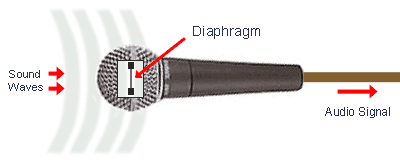
Dynamic microphones
Dynamic microphones are the most simple in their design so they would be a great way to start with . Because of their simple design and versatility they are great for being used in almost all of the situations , from recording in a studio to being used in live settings ( for singers , micing up a guitar cabinets and drums ) . They are much cheaper than all of the other types of microphones , so chances are that if you own one , it's most probably the dynamic one . They are also very sturdy both in their ability to withstand almost infinite amount of loudness without damaging the diaphragm and also in their general ability to withstand hits to the ground and years of wear and tear . I'll explain how they work by using the following picture .
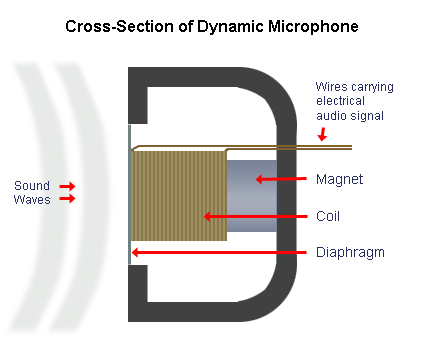
Dynamic microphones convert the signal to an electric one by the electromagnet principle . The diaphragm is attached to the coil which surrounds the magnet . Once the sound wave reaches the diaphragm , the diaphragm vibrates and moves the coil of wire along with it . According to the electromagnetic principle , any metal wire that resonates near a magnet induces electricity . In this case , the coil of wire moved back and forth by the diaphragm induces electric signal which is being channeled along the wires to the receiving source .
The dynamic microphones are in most cases tailored for a specific application , so they have a pronounced frequency response depending on the application . For example , a microphone made for micing up a kick drum , will have a frequency response tailored to enhance the low fundamental frequencies of a kick drum as opposed to a vocal mic which will have enhanced for example upper mid range to make the singer cut trough the mix .
Condenser microphones
I guess that the right name for this type of microphones would be capacitor mics , but the term condenser just kind of stuck . As the other name suggests , these microphones work by using a capacitor and electric signal is produced by the means of electrostatic force . To better demonstrate i'll use the following picture .
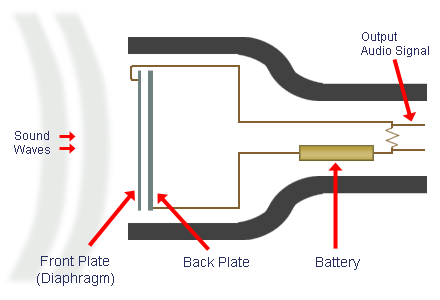
Here we have a sound wave hitting the capacitor . The capacitor is made up of two metal plates . The one on the front end of the sound wave is very thin ( that's also a diaphragm ) and a thicker one which is found on the back end . These two plates are very close to each other but not touching each other . So , when the sound wave hits the diaphragm ( the front plate ) it resonates and while doing so constantly changes the distance between the plates . While the plates are closer together capacitance is increased and a charge current is being formed and when the plates are further apart discharge current occurs . This means that the plates need to be fed a current in the first place in order for this phenomena to take effect . This current fed to the plates is called phantom power and is ranging from 9 V to 48 V . This means that the condenser , unlike dynamic microphones , need a separate power supply . This is usually built in the microphone amplifiers , so you usually don't need to buy a separate unit only for that .
Condenser mics are great for catching subtle nuances in music performance but it comes at a price . Because of this they are very fragile and are mostly used in studios . They have a flat frequency response , but louder signals will cause it to distort . It is mostly used for recording vocals , acoustic guitars and generally everything which is subtle and needs that shimmering high end .
Ribbon microphones
Ribbons are essentially a dynamic microphones but the way they work is slightly different . Instead of a coil of wire we have a ribbon which is found between two poles of a magnet. The ribbon has wires connected to the each of its sides . Once the sound wave hits the ribbon ( in this case acting as a diaphragm ) it vibrates between the two magnets thus creating electric charge which is being transferred by the wires at the ends of the ribbon .
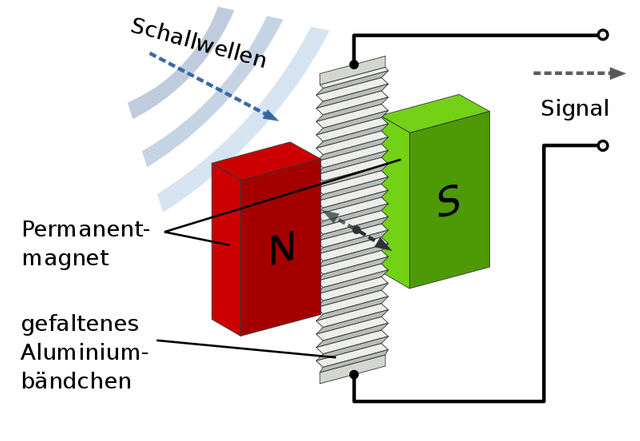
Ribbon mics are great for any application and they are my personal favourites . They have very smooth frequency response in the higher register of the spectrum and everything with them sounds warm but not dull . They have a very specific vintage sound which i very much like , and it works wonders on vocals . It makes them present but naturally take away the unpleasant harsh frequencies , especially if you have a very aggressive rock singer .
Directional properties
Microphones are also categorized by their directionality . This means that they pick up sounds from different angles and sides differently or not at all . Accordingly we can divide them into 3 categories .
- Omnidirectional
These mics pick up sound evenly from all around them . This may be great for certain applications but very undesirable for other . For example you may want to record a chamber orchestra . You place an omni in the center and you are good to go . On the other hand recording a single vocalist will introduce some ambient noise coming from all of the sides of the microphone . This polar pattern is in user manuals generally presented like this :
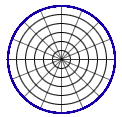
- Unidirectional
These mics pick up the sound from a single direction . They can be cardioid and hypercardioid
They are used in most of the scenarios as they do not introduce any ambient noise by picking up only what is in front of them and a slight bit on sides , but none of the sounds coming from behind it .
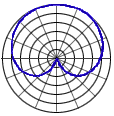
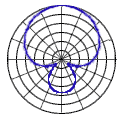
- Bidirectional
These mics do not pick anything on the sides , but rather on front and the back only . They can be useful when dealing with two singers at the same time so that you do not need to put two microphones and risk having phase issues .
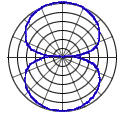
And that about covers it all about how the microphones work . This is fairly basic knowledge about them , but i hope that i might have sparked your curiosity to explore them some more , or you might be perfectly fine with all the information provided in this humble post of mine . In any case i hope it was of any use to you .
Thanks for reading and take care :) - Unidirectional
This post has been voted on by the SteemSTEM curation team and voting trail in collaboration with @curie.
If you appreciate the work we are doing then consider voting both projects for witness by selecting stem.witness and curie!
For additional information please join us on the SteemSTEM discord and to get to know the rest of the community!
Nice post! I remember learning about how all my music equipment worked about a decade ago when I was taking music in college. It's pretty crazy how simple it is to make a mic, yet intricate enough for a high quality mic to be up there in price. I'm sure most people take this information for granted. Pretty much applies to all musical equipment; it's simple to make but expensive to produce high quality. Knowing this stuff also helps you get better/different sounds from the same microphone depending on where you place it and on its properties. Combining that with knowledge about how a speaker works and what different sounds come from the different areas of the speaker really allow you to get a wide range of sounds from the same mic/speaker setup on a guitar.
Oh yes indeed ! The art of recording is really like learning a new instrument in terms of amount of time you have to invest in order to become a master of it . But even if you do not want to become a pro audio engineer still , as you said , it is time well spent . Knowing that stuff really steps up your game as a professional musician :)
This post was shared in the Curation Collective Discord community for curators, and upvoted and resteemed by the @c-squared community account after manual review.
@c-squared runs a community witness. Please consider using one of your witness votes on us here
Can someone recommend a great ASMR micro?
Exploring the nitty-gritty of gear is such a cool journey, isn't it? Microphones are these fascinating little devices that pack a punch when it comes to sound capture. It's wild how something seemingly simple can have such a huge impact on what we hear! The intricacies in their design totally shape the way they pick up sound. Have you checked out https://asmrmicrophones.com/? It's a goldmine for diving into different mic types and understanding those nuances in design that make all the difference in our recordings.